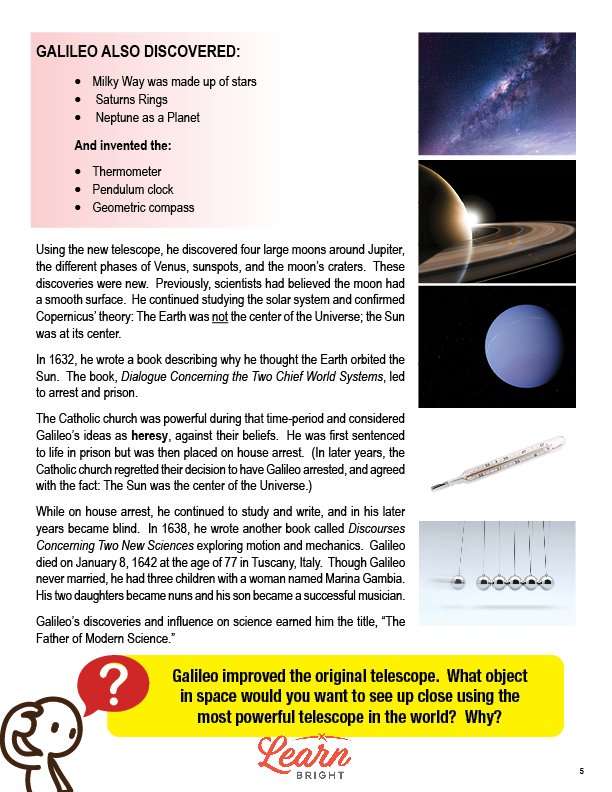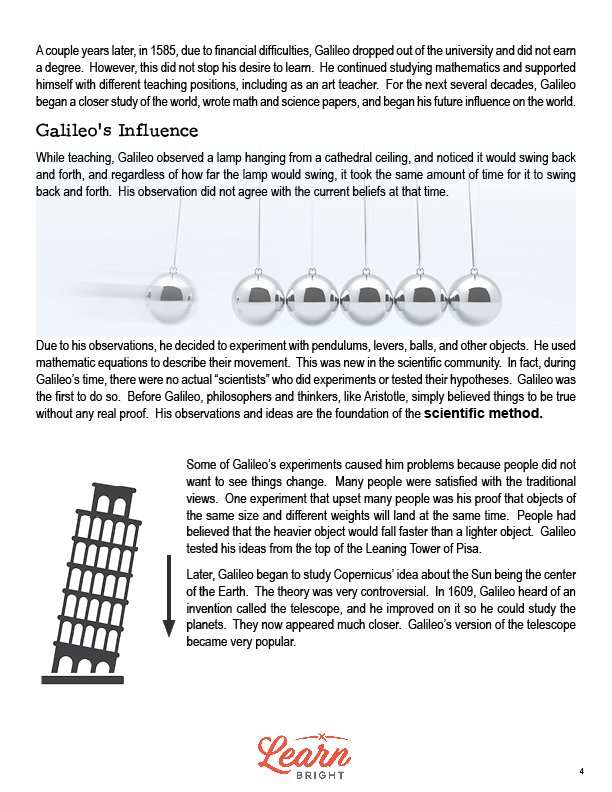Description
What our Galileo Galilei lesson plan includes
Lesson Objectives and Overview: Galileo Galilei introduces students to Galileo Galilei and his life. The lesson explores his accomplishments, discoveries, and inventions for astronomy, as well as his influence on science. Galileo laid the foundation for the scientific method which is used by scientists everywhere. At the end of the lesson, students will be able to identify Galileo Galilei, list significant contributions, and explain his influence on the world and science. This lesson is for students in 3rd grade, 4th grade, 5th grade, and 6th grade.
Classroom Procedure
Every lesson plan provides you with a classroom procedure page that outlines a step-by-step guide to follow. You do not have to follow the guide exactly. The guide helps you organize the lesson and details when to hand out worksheets. It also lists information in the orange box that you might find useful. You will find the lesson objectives, state standards, and number of class sessions the lesson should take to complete in this area. In addition, it describes the supplies you will need as well as what and how you need to prepare beforehand. The supplies you will need for this lesson are books, string, tape, metal washers, scissors, marbles, cardboard, other items used to make a ramp and pendulum, and the handouts. To prepare for this lesson ahead of time, you can gather the supplies and copy the handouts.
Options for Lesson
Included with this lesson is an “Options for Lesson” section that lists a number of suggestions for activities to add to the lesson or substitutions for the ones already in the lesson. One optional addition to this lesson is to demonstrate the Galileo experiments for your class. You can also use interactive resources alongside the experiments. You could plan a Galileo Day, where other classes in the school would visit and students would demonstrate experiments and share information about Galileo. Another idea is to plan an evening activity for students to look at the sky with a telescope. Finally, you could also have students research Aristotle and Copernicus at the same time.
Teacher Notes
The teacher notes page includes a paragraph with additional guidelines and things to think about as you begin to plan your lesson. This page also includes lines that you can use to add your own notes as you’re preparing for this lesson.
GALILEO GALILEI LESSON PLAN CONTENT PAGES
Sun Revolves Around the Earth?
The Galileo Galilei lesson plan includes three content pages. The lesson begins by asking students if they knew that, at one time in history, people thought that Earth was the center of the universe? This was a common belief in the early 1500s. People thought that the moon, Sun, stars, and other planets revolved around the Earth, until Nicolaus Copernius, an early astronomer and scientist, proposed the idea that the planets actually revolved around the Sun. He didn’t have every detail correct, but he did not think that the Earth was the center of the universe.
People did not immediately accept Copernicus’ models, though scientists did start to accept his ideas nearly a hundred years later. However, many people didn’t believe it. Galileo Galilei did believe this idea, and because of that, they arrested him and sent him to prison. This didn’t change his mind, however, and is one of the reasons why he’s now one of our most famous and influential astronomers and scientists.
Early Life of Galileo
Born on February 15, 1564 in Pisa, Italy, Galileo Galilei was the oldest of six children. He was the son of a well-known musician and music theorist, and his family moved to Florence, Italy when he was 10 years old. In Florence, Galileo started his formal education at a monastery. A monastery is where a religious community lives. He went to school for nine years.
He enrolled at the University of Pisa in 1583 to study medicine, but found many subjects interesting, including math and physics. It was during this time that he learned about Aristotle’s view. At that time, Aristotle was the leading scientific authority approved by the Roman Catholic Church. This meant that anyone who spoke against Aristotle or his teachings was in trouble.
Galileo dropped out of university in 1585 due to financial difficulties. He did not finish his degree, but he still had a desire to learn. He studied mathematics on his own and earned money as a teacher. Galileo did this for a few decades, learning more and more and writing math and science papers.
Galileo’s Influence
One day, Galileo noticed a lamp hanging from a cathedral ceiling, noting that it always took the same amount of time to swing back and forth, regardless of how far it would swing. This observation was at odds with the current scientific beliefs of that time. This observation led him to experiment with pendulums, balls, levers, and more, using mathematical equations to describe the movement. During this time, scientists did not do experiments or test hypotheses. Galileo was the first to do that! Instead, philosophers and thinkers, like Aristotle, just thought things were true and didn’t test them. We consider Galileo’s observations and experiments to be the foundation for the scientific method.
At that time, people were not excited about Galileo’s experiments. No one wanted things to change, and wanted to continue using the traditional views and methods to understand the world. An experiment that he did that proved that objects of the same size but different weight fell at the same rate and landed at the same time was particularly upsetting to people. Until that point, people thought that heavier objects would always fall faster. Galileo actually tested this idea by dropping things off of the Leaning Tower of Pisa!
Galileo also studied Copernicus’ idea that the Sun was the center of the universe. This theory was still very controversial during Galileo’s time, but, in 1609, Galileo improved the telescope so that he could study the planets. This version of the telescope became very popular. He also discovered the Milky Way and its stars, Saturn’s Rings, and Neptune. He invented the thermometer, pendulum clock, and geometric compass.
Using his new telescope, Galileo discovered moons around Jupiter, different phases of Venus, sunspots, and the moon’s craters (people thought that the moon was smooth). Through his studies of the universe, he confirmed Copernicus’ theory. He wrote a book about this in 1632 called Dialogue Concerning the Two Chief World Systems, and they arrested him for it.
The Catholic Church considered Galileo’s ideas to be heresy, or against their beliefs. They were very powerful at this time, and they sentenced him to life in prison, but later put him on house arrest instead. The Church would later accept that the Sun was the center of the Universe.
Galileo kept studying and writing while on house arrest. He eventually became blind. However, in the meantime, he wrote a book called Discourses Concerning Two New Sciences in 1638, where he explored motion and mechanics. On January 8, 1642, at the age of 77, Galileo died. He never got married, but did have three children; his daughters both became nuns and his son became a musician. Due to his contributions to science, we call Galileo “The Father of Modern Science.”
Key Terms
Here is a list of the vocabulary words students will learn in this lesson plan:
- Nicolaus Copernicus: First discovered the Earth revolved around the Sun
- Galileo Galilei: The Father of Modern Science
- Monastery: A school run by a religious community of monks
- Aristotle: A philosopher and scientific authority for the Catholic Church
- Scientific method: Used by scientists to prove their theories and hypotheses
- Heresy: When a person goes against the teaching of a religion
GALILEO GALILEI LESSON PLAN WORKSHEETS
The Galileo Galilei lesson plan includes three worksheets: an activity worksheet, a practice worksheet, and a homework assignment. You can refer to the guide on the classroom procedure page to determine when to hand out each worksheet.
MARBLES AND RAMPS ACTIVITY WORKSHEET
Students will work with a partner to complete the lesson activity. Each pair will be given the supplies needed to make a ramp and pendulum. They will recreate a few of Galileo’s experiments related to motion and gravity. They will do this be creating three different sized ramps. The students will roll marbles down each ramp and estimate the amount of time it takes for marbles to roll down each ramp. They will sketch the design of each of their ramps and write their results on the chart on the worksheet.
Next, they will drop different objects to the floor from the same height, observing and recording the differences in each drop. Finally, they will create a pendulum and will compare the amount of time it takes to swing back and forth with different lengths of string. They will sketch a drawing for each pendulum and record their results. They will end the activity by writing down what they and their partner have learned about motion based on Galileo’s experiments.
Students can work alone or in larger groups for this activity.
UNIVERSE PRACTICE WORKSHEET
For the practice worksheet, students will first draw and label two pictures: one that shows the original belief about the universe in the 1500s and one that shows the facts about the universe proven by Galileo. They will then place 11 events from Galileo’s life in order and then complete a vocabulary exercise.
GALILEO GALILEI HOMEWORK ASSIGNMENT
The homework assignment asks students to first combine digits to match significant events in Galileo’s life, using each digit once. They will then name three things he discovered and three things he invented. Finally, they will write down why Galileo was called the “Father of Modern Science.”
Worksheet Answer Keys
This lesson plan includes answer keys for the practice worksheet and the homework assignment. If you choose to administer the lesson pages to your students via PDF, you will need to save a new file that omits these pages. Otherwise, you can simply print out the applicable pages and keep these as reference for yourself when grading assignments.










